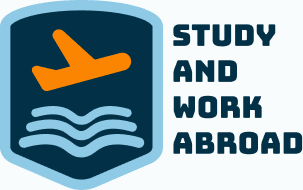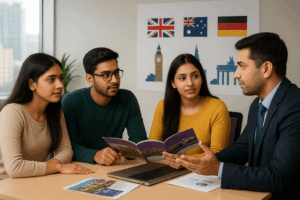Call Us:+91-9920234749, +91-9833420909 info@studyandworkabroad.in
Genuine Student Requirement: The Replacement of the Genuine Temporary Entrant (GTE) for Australia
Australia has traditionally attracted international students seeking high-quality education. Due to the rising number of applicants, the Australian government took steps to verify student visas. The Genuine Student Requirement superseded the Genuine Temporary Entrant criterion.
This change significantly alters the Australian student visa application process. In this article, we’ll discuss the causes for this big change, the Genuine Student Requirement, and how it affects international students.
Why the Shift from GTE to GS?
In 2011, the GTE was implemented to ensure that student visa applicants could study in Australia temporarily and not utilize the visa for immigration. The GTE was useful, although it confused applicants and sometimes severe assessments rejected visas to legitimate students.
The Australian government replaced the GTE with the Genuine Student Requirement due to these issues. The GSR simplifies and transparently documents the visa application process while retaining the integrity of the Australian education system.
The government recognizes that many students may pursue permanent residency after graduating. Therefore, the Genuine Student Requirement emphasizes the applicant’s sincere desire to study rather than their temporary stay.
What is the Genuine Student Requirement?
The Genuine Student Requirement has been updated for Australian student visa applications. It tells them if they want to come to Australia to study. To see if applicants are serious about college, the GSR looks at their academic history, how stable their finances are, and how relevant the course is to their past education and job goals.
Key Components of the GSR
- Academic Qualifications:
The GSR carefully checks candidates’ school records to make sure they can do the course in Australia. They will look at their school record, how well they speak English, and any gap years between studies.
- Relevance of the Course:
The GSR assesses the alignment between the applicant’s selected course in Australia and their educational and professional objectives. This ensures that the applicant is enrolling in a course that will facilitate their entry into Australia and enable them to achieve their career objectives.
- Financial Stability:
The GS Test evaluates the applicant’s financial capacity to support themselves during their stay in Australia. This includes assessing their ability to pay for tuition, living expenses, and other costs associated with studying abroad.
- Future Career Plans:
The Genuine Student Requirement assesses the applicant’s career objectives and evaluates how the course in Australia will facilitate the achievement of those objectives. The applicant has a desire to pursue education in Australia.
- Previous Visa History:
When an individual undergoes the GSR, it assesses their visa history, encompassing all instances of visa denials or revocations. A clean visa history indicates the applicant’s commitment to adhering to visa regulations.
- Statement of Purpose:
In order to complete the GSR, you must possess a meticulously crafted Statement of Purpose (SOP). The individuals must engage in a discussion regarding their rationale for selecting Australia, the chosen course of study, and how it aligns with their professional aspirations.
How the GSR Differs from the GTE
The GS Test, while replacing the GTE, offers several improvements over its predecessor:
- Attention to Education:
The GTE test focuses on the applicant’s plans to return home after graduation, while the GS test focuses on schooling. It acknowledges that many students may pursue work or permanent residency in Australia if their main goal is education.
- Clarity and Transparency:
The GTE is less transparent than the GSR. The requirements are explicit and focus on the applicant’s real desire to study rather than leave Australia after that.
- Less Confusing:
It was said that the subjective GTE led to problems with visa acceptance. The GSR makes the standards clear for both applicants and visa officers so that there is no confusion.
- Balanced Approach:
The GSR is fairer because it looks at both the applicant’s job chances and how relevant the course is to their life. Dedicated students are not punished unfairly for wanting to do work of their choice in the future.
Preparing for the Genuine Student Requirement
For international students applying for visas, it is important to understand and prepare for the GSR. How to get through the process:
- Research Thoroughly:
Before applying, find out more about the college and the field. Make sure the course fits with what you’ve already learned and what you want to do with your job. This will help you explain your choice for the SOP.
- Prepare a Strong SOP:
Your SOP affects the GSR. Why did you choose Australia, the course, and how does it fit into your plans for your career? Write an interesting story about it. Describe the gaps in your school and work history and explain why you picked them.
- Demonstrate Financial Stability:
Make sure you can afford tuition fees, daily expenditures, and other Australian study costs. Provide bank statements or sponsorship letters to prove your financial stability.
- Highlight Your Academic Achievements:
Highlight your academic success in your application. Transcripts, certificates, and ELP results are required. Excellent academic performance will prove your student status.
- Be Honest and Transparent:
The Genuine Student Requirement needs honesty. Share your aims, visa history, and other pertinent information. Fraudulent statements might result in visa rejection and harm future applications.
- Get Professional Guidance:
Understanding the GSR and visa application can be difficult. Consult Australian student visa education advisors or migration agents. They offer insights and help you write a successful application.
Conclusion
Australia’s student visa assessment has changed since the Genuine Student Requirement replaced the Genuine Temporary Entrant criterion. The GSR is more fair, open, and focused on education, so real students have a better chance of getting a visa. Knowing what you need to do to do well on the GSR and working hard will help international students do well and feel confident as they begin their studies in Australia. Keep connected with Study And Work Abroad if you want to know more



